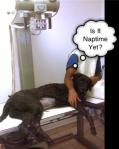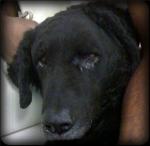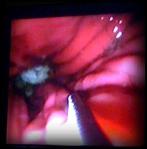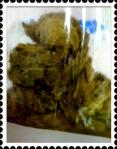8-Year Old Curly-Coat Retriever Takes a Long Road to a Simple Answer
A Canine Officer with Lack of Interest in Work is a Big Problem!
Warning: This is a technical, geeky, post. Have organic green tea or organic coffee before reading! (If you are wondering about tests your vet has ordered on your dog, this post explains many advanced tests.)
Titus, an 8 year-old Curly Coat Retriever sat on my examination table with a forlorn look on his face. (The white fur around his eyes in the picture is normal for him after he had entropian (rolling in of the eyelids) surgery years ago, the new fur grew in white instead of black.) His handler of 6 years from the Narcotics division looked equally dismayed and worried.
“Doc, Titus just doesn’t have his drive anymore. He was the best dog in the unit. Now he just doesn’t want to work sometimes. The other day, he actually just sat down in the middle of a search and refused to move. That’s not like him!” he said, “Maybe he’s upset because I started training the new Malinois.”
Doc Truli agreed Titus had never looked so depressed. Even when he flipped his stomach and bloated a few years before, and then got a hand towel stuck in his intestines two weeks after that. Even then, Titus looked energized and happy to work. Jealousy would not cause the awful “down” look on Titus’ face. We worried he was getting old.
“I hate to have to retire him, he’s my best dog. But if he doesn’t feel like working anymore, then that’s it,” said his handler.
“Remember, old age is not a disease. There is an answer to this problem,” said Doc Truli.
Titus’ Diagnostic Work Up for the Symptom “Lack of Interest”
Thorough, Detailed Physical Examination
The physical examination revealed slightly stiff hip joints. We knew Titus was negative for the Degenerative Neuropathy gene that some Retrievers, Shepherds, and other dogs can express as progressive loss of strength and function in the hind legs. (Your veterinarian can contact a veterinary neurologist to ask how to become eligible for this free test that is still in the research stage and not commercially available.) We knew he had a small contribution of osteoarthritis in his left hip. Titus had been under multimodal arthritis management for years and seemed stable and happy.
Minimum Database: Complete Blood Count, 25 Blood Chemistry, Urinalysis, Heartworm, Fecal Analysis
Tests revealed low blood albumin. Otherwise, no evidence of pancreatitis (Pancreatic Lipase Immunoreactivity test negative), metabolic disease, hormonal, endocrine-type disease, no signs of hidden infection. Doc Truli knows that the body tightly regulates albumin protein in the blood because of albumin’s essential importance for blood pressure and homeostasis in the body. Either Titus was not making enough albumin in his liver, or he was loosing albumin through his kidneys or his intestinal lining.
Advanced Diagnostics
Bile Acid Test: Pre and Post Prandial (Prandial means Eating in Doctor-speak)
A bile acids challenge tests Titus’ liver function.
A bile acids test involves fasting your pet for 12-16 hours. Then the veterinary team draws a blood sample and feeds your dog a small amount of food to challenge the liver and bile acids system and see if it responded properly to the food. After 2 hours, we check the blood again. Based on the levels before and after eating, the pattern provides valuable information about liver function.
Titus’ bile acids test came back normal. So his liver synthesized albumin normally. This left albumin leakage out of the body as an explanation for the hypoalbuminemia (low blood albumin). There are two main ways albumin sneaks out of the body: through the glomeruli (pronounced glow-mare-you-lie) filters in the kidneys, which indicates kidney damage, or through a leaky gut wall.
Urine Protein:Creatinine Ratio Clearance Test
Max’s urine showed some extra leaking protein. A special test called a urine to creatinine protein ratio showed a higher than normal level of protein leaking through the kidneys compared to the amount of creatinine the kidneys were expelling from the body. Basically, you don’t know if the protein in the urine is because of more urine overall or more protein in normal urine. You have to compare the protein in the urine to a close approximation of urine output, which is the urine creatinine clearance number.
Of course, Titus’ urine tested negative for a urinary tract infection. If your dog has a urinary tract infection, the white blood cells that enter the urine to fight the infection contain protein, especially in their cell nuclei, and they invalidate the assumption that the protein leaked through the filters in the kidneys.
“If your dog has a urinary tract infection, the urine protein creatinine ratio test is invalid,” cautions Doc Truli,”This is one reason your veterinarian is ordering a urine culture and sensitivity test, even if your dog does not show symptoms of a urinary tract infection.”
Titus’ urine showed some abnormally high levels of protein loss, but not enough to account for the problem. In his case, that left leakage through the intestines.
Alpha-1 Proteinase Inhibitor Test
We do an alpha-1 proteinase inhibitor test on 3 poop samples from three separate bowel movements. The frozen samples ship to the gastroenterology laboratory at Texas A&M College of Veterinary Medicine (the only place on the world set up to run this test.) This test will prove the protein loss is through the intestines, even in a dog without no signs of vomiting or soft stool.
However, the alpha-1 proteinase inhibitor test takes sometimes 2 weeks for results. And, if the problem is only in the stomach, and not in the intestines, the test will look normal. Most sick dogs cannot wait 2 weeks for an answer; they will become too weak and sick in the meantime.
Diagnostic Imaging
Radiology (X-Rays) and Ultrasound
Titus transferred to radiology and we x-rayed his abdomen. Nothing too distinctive there. We ultrasounded his abdomen. Nothing bad there. We fed him some barium.

Titus shows little enthusiasm or energy as he lounges on the x-ray table. His belly was shaved for the ultrasound study.
What is a Barium Series and What Can It Show?
A barium series consists of your dog eating liquid barium (some formulas taste like strawberries). The barium is a liquid metal that is not unhealthy and shows up bright white on radiographs (the real word for x-rays). Any obstructions in the intestines, or masses, growths, lumps of cancer, and we assess the transit time it takes for the barium to travel through the parts of the gastrointestinal system. It usually takes at least 12 hours of snapping radiographs every few hours or so until the pattern of transit through the “plumbing” can be appreciated.
“Why does my dog need radiographs (x-rays), and ultrasound? Don’t they both take pictures of inside the abdomen?”
Many people wonder or ask this question.
“Radiographs show the relative sizes and positions of the abdominal contents. They highlight bone and mineral material, and show gas or liquid build-ups in the intestines well. Ultrasound can highlight the inside of the organs well and allow doctors to see the structure and texture of the liver, spleen, kidneys, intestinal walls, adrenal glands, lymph nodes, etc. But ultrasound can miss even large lumps in the abdomen because the intestines move around all the time.
There is no way to mark or tag each region that has already been seen and be sure you are moving on to a new section. This is also the limitation in using ultrasound to count kittens or puppies in the womb. Unless they all show up on the same computer screen together at the same time, you can never be sure if you are single or double-counting the little ones!” explains Doc Truli.
Titus’ barium series showed a tiny area of barium left in his stomach 12 hours after eating. And it showed a “possible thickening of the pylorus” (the outflow sphincter of the stomach.) That was all!
Digital Camera Endoscopy: “Scoping”
Because no intestinal obstruction appeared, and a digital camera endoscope reaches the stomach, Titus went under anesthesia and a scope snaked down into his stomach.
What do you think we found? Remember all his tests showed nothing. Only some protein leaking from somewhere in his intestines.
- Nothing
- Ulcers
- A blockage
Well, I’ll show you what we found:
First, this picture shows the first sign we knew there was something in there.
After about 2 hours of grabbing and slowly pulling out pieces of material and rope and towel and whatnot (we even found a piece of embroidery fabric in there!), we had a plastic bag full of the blockage material. Keep in mind, none of this goop showed on the tests!
Titus recovered with some medication to protect any scraped and sore areas. He returned to eating with gusto, gained weight, works like a champ, and has a relaxed, happy look on his face once again!
No retirement for this canine Narcotics officer!
(P.S. To read a short, medical story about a chihuahua mix with the same sort of problem as Titus, but very different symptoms, check out Mystery Weight Loss Traced to a Toy)








Recently my 9 year-old golden retriever began having problems standing on wood floors, his back paws would slide sideways and he would have trouble holding himself up or otherwise walking. This was especially true when he first woke up in the morning, his back legs seemed stiff and he also had trouble going down stairs. He did not have as much trouble on carpets or outside, but it was clear he was having some joint issues.
It is amazing what they can do with Veterinary Endoscopy that no other method can. This dog was very lucky that with all the stuff he had eaten, you were able to remove it and he is perfectly fine. What a great story.
the story about the curly coat retriever was great !!!
I have a 3 year old beautiful curly that I love more than most people, and def. more than life itself…
He eats everything he can, I’m always on constant lookout catching him sneaking socks, towels, underwear, etc…
He’s rippped apart and chewed every stuffed toy, to the point where he can’t have them anymore in case he eats the fuzzy stuffing…
He chewed apart his entire dog bed as a puppy and swallowed some of the stuffing…
He even chewed and swallowed his gentle leader and part of a leash, and his rubber kong ball with the food inside it…
Most recently he chewed the seatbelt in my car which turned into shreds, costing over $300.00 to replace…
He even chews his nails so that I have to have them ground down when they’re clipped, or they become like
dangerous sharp points…
It’s very frustrating but is slowing down somewhat as he gets older….I know all dogs, esp. puppies, will chew nonstop, but my curly swallows what he chews…
I try to catch whatever I can before he eats it, but sometimes I can’t get there fast enough…
In the dog park (offleash) he eats sticks and grass and leaves, even the woodchips, if I’m not looking…
However, with everything that’s gone into him, he’s never been sick and seems to pass everything through…As gross as this sounds, I see numerous remnants in the poo…But now I wonder if he has fibres and cloth etc still in his intestine…it’s highly possible…
It’s really amazing what vets can do now…thanks so much for such a great story…I’m sure they must see many fascinating things in the course of a day!!!
I’m going to email this article to my own vet, not only is it interesting, it’s very informative…thanks again…
dorothy
london ontario
Dear Dorothy,
I’m so happy to hear that your Curly-Coat Retriever boy has not had any problems with his *ahem* extra snack items!
Yours,
Doc Truli